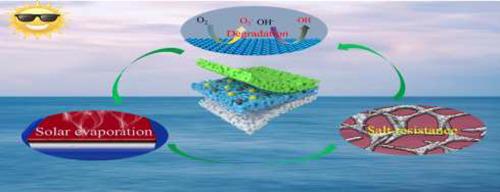Separation and Purification Technology ( IF 8.1 ) Pub Date : 2022-07-02 , DOI: 10.1016/j.seppur.2022.121643 Linjiang Zhang , Xuechun Wang , Xiaohui Xu , Jun Yang , Junfeng Xiao , Bo Bai , Qizhao Wang

|
The expeditious advancement of solar-driven interfacial steam generation by utilizing renewable and free solar energy is a promising strategy for remedying the water crisis. However, salt accumulation on solar evaporators and organic pollutants increases in the remaining bulk water block its commercial potential for practical applications. Herein, a Janus solar evaporator was designed by using a commercialized melamine sponge as the matrix, followed by PDMS modification and deposition of Chinese ink, and TiO2 nanoparticles. The Janus photothermal melamine sponge (JPMS) was designed with containing a hydrophobic salt resistance layer, and a composite photothermal and photocatalysis layer from top to bottom. The applicability of the developed JPMS was systematically investigated for water evaporation, photocatalytic degradation, desalination as well as wastewater treatment. The JPMS exhibits an evaporation rate of 1.49 kg m-2h−1 with a corresponding efficiency of 93.54% under 1 sun illumination. Notably, the JPMS also exhibits the high efficiency of synergic photocatalysis for organic pollutants and acquires an excellent salt rejection capability. Integration of SISG, photocatalytic, and salt resistance may be viewed as a prospective avenue for water purifying.

































 京公网安备 11010802027423号
京公网安备 11010802027423号